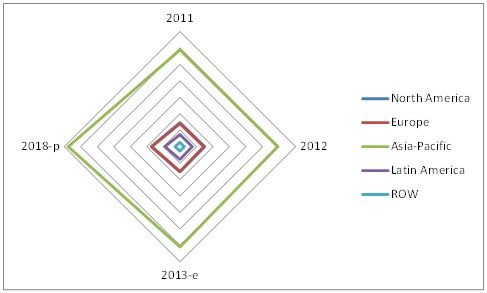Fertilizers, as we all know, are added to soil to boon the growth of plants as they supply vital nutrients for plants growth.Fertilizers may be organic or inorganic yielded naturally or synthetic. Depends on the nature of the soil, such as whether it is acidic or alkaline; sandy, clay or rocky; and weak or rich, the choice is made for the fertilizers to be used for speed growth.
Types
Organic
These are natural and includes
things such as bat guano, compost, peat moss, wood ash and manure, generaly
soil amendments. They don't burn or harm plants, and they can have long-term
positive effects on the soil without damaging groundwater.But they generally
have lower nutrient concentrations than inorganic fertilizers
Source - http://patwelsh.com/wpmu/files/Options-for-Organic-Fertilizers_large-300x270.jpg
Inorganic

Typically comes as a powder,
pellets, granules or a liquid , which are man-made. Plants absorb nitrogen (N),
phosphorus (P) and potassium (K) as chemical additives which are examples of inorganic
fertilizers.These three essential elemental nutrients should naturally occur in
healthy soil, but some plants require more of them. Other chemicals that might
be included in inorganic fertilizers include calcium, sulfur, iron, zinc and
magnesium.
Source -http://www.buzzle.com/img/articleImages/383327-28127-53.jpg
Demerits of inorganic fertilizers
- Soil acidification
- Water pollution
- Contamination with impurities
- Fertilizer dependency
- Trace mineral depletion
- Over fertilization
- High energy consumption
- Contribution to climate change
- Impacts on mycorrhizas
- Lack of long-term sustainability
Nitrogenous Fertilizer
The nitrogen in CAN is made up by
the slow ammonium nitrogen and the fast nitrate nitrogen at equal ratio,
therefore, it can be applied for both top dressing and basic fertilization for
any kind of soil types and vegetation. The dolomite content with the nitrogen
reduces the sourness of the soil, so it is specifically recommended for
treating sour soils. Calcium (magnesium) improves the soil structure, as its
clay/humin complexes make it crumbly (water, heat and air retaining capacity of
the soil will be better due to porosity), and increases its fertility. It
increases the absorption and utilization of other nutrients through improving
the ion balance.
Market value
 |
| Nitrogenous Fertilizers Market Value, by Geography, 2011-2018 ($Million) |
In 2012, the global nitrogen fertilizers market generated a value of
$98,627.9 million and is anticipated to grow at a CAGR of 2.2% by 2018.
The market is led by urea by type with the fastest growing CAGR and
market share. The market was led by Asia-Pacific by geography in 2012;
this trend is expected to continue till 2018.The ammonium nitrate market
was led by Europein 2012.
For more info - http://www.marketsandmarkets.com/Market-Reports/nitrogenous-fertilizers-market-243341881.html

Hey I’m Martin Reed,if you are ready to get a loan contact.Mr Benjamin via email: 247officedept@gmail.com ,WhatsApp:+1 989-394-3740 I’m giving credit to his Service .They grant me the sum 2,000,000.00 Euro at the return rate of 2% ROI. Within 5 working days.Mr Benjamin works with group investors into pure loan and debt financing at the low ROI to pay off your bills or buy a home Or Increase your Business. please I advise everyone out there who are in need of loan and can be reliable, trusted and capable of repaying back at the due time of funds.
ReplyDelete